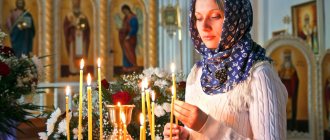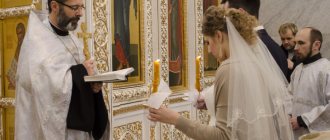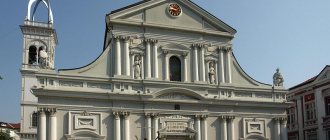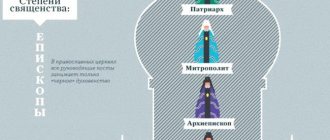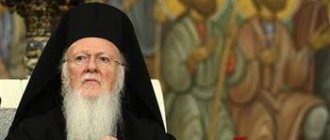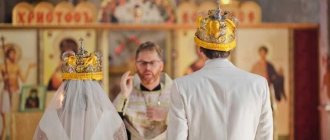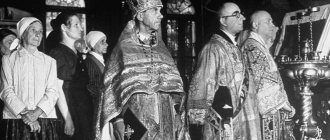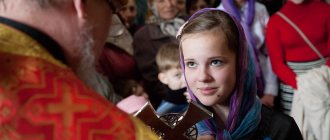History of the emergence of the Greek (Helladic) Orthodox Church
Officially, the Greek Church is one of the youngest in the Orthodox world. But the history of Christianity in these lands goes back 2 thousand years.
Base
Orthodoxy was brought to the Greek lands by the Apostle Paul. Arriving on the Macedonian coast, the preacher addressed the Word of God to the residents of the cities of Kavala and Philippi. In the latter city, under the influence of the apostle’s preaching, the family of a wealthy city dweller, Lydia, was baptized. They were the first Christians on the European continent.
Saint Apostle Paul was the first missionary to Greek lands
Then the beloved disciple of Christ went south, where he converted the inhabitants of Athens, Thessaloniki and Corinth to the true Faith. He bordered these communities until the end of his earthly journey. Also, Christianity was spread in Greece by the apostles Luke, John the Theologian and Andrew the First-Called.
A century later, Christian communities spread throughout Greece. Until the 9th century. submitted to the authority of the Bishop of Rome. At the same time, from the middle of the millennium, the young Byzantine state began to influence the Peloponnese. Officially, the Greek dioceses became part of the Patriarchate of Constantinople. At the same time, the center of Orthodox monasticism was born on the island of Athos.
The Middle Ages were a testing time for the Greek Church. During the Early Middle Ages, Orthodoxy was persecuted by the Crusaders. From the middle of the 15th century. the entire territory of the Balkan Peninsula fell under the yoke of the Ottomans, who defeated the Byzantine Empire.
Important! For almost 400 years, Christians died at the hands of the Ottoman Muslims. At the same time, it was the clergy who made a lot of efforts to preserve Greek traditions, language and national identity. They led the popular resistance, which led to the overthrow of Ottoman rule and the formation of an independent Greek state.
Declaration of Independence
In 1833, on the initiative of the secular authorities, the autocephalous Greek Church was formed. The ruling monarch was proclaimed its head. This organization was not recognized by either the Ecumenical Patriarch or the Local Churches until 1850.
Over the next 100 years, the territory of the local church, as well as its internal traditions, took shape. The Second World War brought new challenges to the Greek clergy: a shortage of priests, a large number of destroyed churches. Under these conditions, the state government took upon itself the care of the Orthodox Church. The 1975 Constitution officially established the state status of Orthodoxy.
Martyrs
The Greek Church survived despite severe persecution in the 13th and 14th centuries from the crusaders, who occupied large areas of Hellas. In the 15th century, the Ottoman yoke, which was difficult for the country, began. With the fall of Byzantium in 1453 and the reign of the sultans, the era of the new martyrs flourished, which lasted 400 years. Hundreds of thousands of people gave their lives for the Greek Church and their faith.
Teachings about Orthodoxy were often secret - monks and clerics, in secret from the ruling regime, organized underground societies that operated at night.
Hierarchy of the Greek Orthodox Church
The church hierarchy is also enshrined in the main state document of Greece. In accordance with it, the main governing body of church institutions is the Holy Council, which consists of the heads of all Greek dioceses holding the rank of metropolitans.
Jerome II - Archbishop of Athens and All Greece
They are appointed by the government of the state. The meeting of bishops elects a head who receives the title of Archbishop of Athens and All Greece. The chosen clergyman must be approved by the head of state within 5 days, after which a solemn enthronement is scheduled.
On a permanent basis, church affairs are governed by the Holy Synod, consisting of the Archbishop of Athens and 12 metropolitans. They occupy the post on a shift basis.
The modern Greek Church consists of 81 dioceses. It is believed that 30 of them are under the jurisdiction of the Ecumenical Patriarch. It should be noted that the territories of the islands of Crete, Dodecanese and Athos, which politically belong to Greece, are under the direct control of the ruler of Constantinople.
Interesting! The division into ancestral and new lands is reflected in the composition of the Holy Synod. 6 out of 12 metropolitans represent dioceses belonging to the jurisdiction of Constantinople.
Attitude
Thus, in Russian realities, ordinary believers, when they come to church, are subjected to a feeling of isolation of priests from the everyday world. They seem to be a separate caste, which is fenced off from the parishioners by some kind of wall. In Greek traditions, clergy are in close relationships with the parish. In everyday life in Greece, there is deep respect for priests - it is customary to give up seats to them on public transport. Often even the youngest representatives of the priesthood are approached in public places with a request for a blessing. There is no such thing in Russian reality.
Differences between Greek Orthodoxy and Russian
The Russian and Greek people are co-religionists. Orthodoxy in Russia and Greece have common dogmatic foundations and service canons. Minor differences lie in the external ritual attributes of the Faith.
Priesthood status
Russian tradition distinguishes ministers of the Church into a special class. Often they distance themselves from ordinary lay people, communicating with them only within church walls. At the same time, the attitude towards clergy in Russian Orthodoxy is characterized by some indifference. Priests and monks in Greece are closer to the common people, being part of them.
Orthodoxy is the official religion in Greece
You can approach them on the street and ask for a blessing. Often after the service, the priest and parishioners sit down at a common table and have tea. At the same time, the Greek servants of the Lord, regardless of age, enjoy universal respect. Even a young man in a cassock will be given a seat in a transport, or a blessing will be asked on the street.
Robes and external attributes
The vestments of Russian priests are distinguished by splendor and richness. Depending on the service, clothes of different colors are used. Greek clothes are characterized by minimalism and laconicism. On special occasions, white robes are used.
The cross in the Russian tradition is an indicator of the status of a clergyman. In accordance with this, the appearance of this Christian symbol differs. For Greek clergy, the cross is a reward for diligent service. It is not worn in everyday life, being worn only for bishop's services.
The opposite situation occurs with the headdress - kamilavka. The Greek headdress is a part of the everyday vestment of a priest. It is produced only in black and has an extension at the top. Kamilavka in Russia is a reward. It is a cylinder-shaped headdress, the color of which depends on the type of service.
Service traditions
Worship in Greece lasts 1-1.5 hours. Most of the service is held with the Royal Doors open in full view of the parishioners. Greeks try to take communion weekly. The lowest church dignitaries, deacons, have the right to receive communion. At the same time, the laity undergo the sacrament of confession 3-4 times a year.
The Bible in the Greek Church differs in the composition of its books from the Church Slavonic
The procession of the cross in the Greek Orthodox tradition is accompanied by the sounds of a brass band. He walks through the streets to the central square of the settlement, where a solemn prayer service is being held. The holiday ends with folk festivities and fireworks.
Orthodoxy is not the only religion in Greece; there are Catholics, Muslims, Jews, etc.
It is impossible to say for sure what faith the Greeks are. This is a country with many cultures. Orthodoxy predominates, but there are also representatives of other religions. A number of sources, citing a Greek website, provide the following statistics:
Supreme Council of Ethnic Hellenes Official website where statistics are provided
- Muslims - 230,000 people;
- Catholics - 58,000 people;
- Protestants - 400,000 people;
- Jehovah's Witnesses - 30,000 people;
- Jews - 5,000 thousand people.
It is no coincidence that Jehovah's Witnesses are called here not a sect, but a religion. The attitude towards a particular religious doctrine and the organization professing it is determined by the state. They are prohibited in Russia, Greece adheres to its position.
There are also 2 thousand people who follow the ethnic religion of Greece - they worship Zeus, Hera, etc.
By leaving a comment, you accept the user agreement
Russia and the Greek Church: history of relationships
The Russian and Greek Churches are closely connected with each other. Their relationship went through several stages.
- At the initial stage, the Greek Church played the role of a guide to the Christian world for the Russian lands. She contributed to the formation of a state on the territory of the Eastern Slavs. The first leaders of the Russian Church were of Greek origin.
- The situation changed after the conquest of Byzantium by the Ottomans. Russia by this time had strengthened its position and began to provide patronage to the Greek clergy. In the XVII-XVIII centuries. More often than not, financial support was refused. By the end of the 18th century, Russia was providing active military assistance to the national liberation movement in the Balkan countries.
- Today, the relations of co-religionists are strongly influenced by the global political situation. The schism began in 2022, after a split broke relations between the Russian Orthodox Church and the Patriarchate of Constantinople, which has a strong influence on the Greek Church. In this regard, Russian priests are prohibited from holding joint services with the Greek clergy.
Pomp
Any foreigner is amazed by the magnificent services held in Russia. In the rituals of the Greek churches, democracy and simplicity are felt in everything. All services last a maximum of 1.5-2 hours, while Russian liturgies can last more than 3 hours. In Greece it is the custom to say all secret prayers out loud.
The order of saying prayers also differs significantly. Such a large number of candles as in Russian churches is never found in any temple in Greece. Greek choirs never include female voices. Although in Russian realities this is practiced everywhere.
Liturgy
The Orthodox Church conducts services according to the Byzantine (Greek) rite. It presupposes the existence of a closed iconostasis, behind which the sacrament of the Eucharist is performed. Communion is performed not with a wafer, but with prosphora (leavened bread) and wine (mainly Cahors). Liturgical worship consists of four circles: daily, weekly, fixed and mobile annual. But some Orthodox churches (for example, Antiochian and Russian Orthodox abroad) began to use the Latin rite since the 20th century. Divine services are conducted in the synodal version of the Old Church Slavonic language.
Rituals
Communion and confession differ greatly in the traditions of these two countries. It is customary for the Greeks to celebrate communion every Sunday, and confession takes place once a year. Russian Orthodox Christians do not receive communion with the same frequency. The rules of the Church in Greece give the right to conduct confession only to blessed hieromonks who arrived from monasteries. There is no such strictness in Russian traditions.
In Greek churches you will never encounter the long queues familiar to Russian parishes to go through the confession procedure. The first conclusion may be the absence of confessions as such here. However, the whole point is that people of Greece come to confession at a pre-agreed individual time, which eliminates the possibility of fuss. Greeks who find themselves in Russian churches are perplexed about the queues for confession. Many people do not understand how a priest is able to confess to an entire parish of several hundred people at once.
The Greek Catholic Church had a great influence on the traditions. Thus, the influence of the West was reflected in the fact that Orthodoxy in Greece uses the New Julian calendar. That is, the Greeks celebrate Orthodox festivals 13 days earlier than the Russians, who live according to the Julian calendar. Appeared in Greek temples and stasidia instead of benches and benches characteristic of Russia.
further reading
- Aderny, Walter F. The Greek and Eastern Churches
(1908) online - Konstantelos, Demetrios J. Understanding the Greek Orthodox Church: Its Faith, History and Practice
(Seabury Press, 19820 - Fortesque, Adrian. Orthodox Eastern Church
(1929) - Hussey, Joan Mervyn. The Orthodox Church in the Byzantine Empire
(Oxford University Press, 2010) online - Cephala, Euphrosyne. Church of the Greek People Past and Present
(1930) - LaTourette, Kenneth Scott. Christianity in the Revolutionary Age, II: Nineteenth Century in Europe: Protestant and Eastern Churches.
(1959) 2:479-484;
Christianity in the Age of Revolution, IV: Twentieth Century in Europe: Roman Catholic, Protestant and Eastern Churches
(1958) - McGuckin, John Anthony (ed.). Encyclopedia of Eastern Orthodoxy
. 2 vols. (Wiley-Blackwell, 2011).
Canonical device
Dioceses
See also Episcopate of the Greek Orthodox Church
- Athens
- Metropolises of "Old Hellas":
- Artskaya
- Argolid
- Glyfada
- Gortininskaya
- Dimitriadskaya
- Zakynthos
- Idrskaya
- Iliyskaya
- Ilionskaya
- Kalavritskaya
- Carystic
- Karpenisian
- Kerkyra
- Caesarian
- Kefallinian
- Kifirskaya
- Kifissiyskaya
- Corinthian
- Larisskaya
- Levkasskaya
- Maniyskaya
- Mantinian
- Megarian
- Mesogean
- Messinian
- Monemvasiyskaya
- Nafpaktos
- Nicene
- New Ioniyskaya
- Novosmirskaya
- Paronaxian
- Patras
- Peristerian
- Piraeus
- Syros
- Stagskaya
- Trikkskaya
- Trifiliya
- Thebes
- Thessaliotis
- Firskaya
- Phocis
- Phthiotis
- Chalkidian
- Aetolian
- Metropolises of the “New Lands” (administered under canonical subordination to the Patriarch of Constantinople):
Catholicity - what is it?
Christ said to his disciples: “Where two or three are gathered together in My name, there I will also be among them” (Matthew 18:20). This means that there is a church wherever there is at least one community, even the smallest one. “Catholicity” is a Greek word. It means “whole”, “universal”. Here we can also remember the covenant that Jesus gave to his apostles: “Go, preach to all nations.” In a geographical sense, catholicity means “universality.”
Unlike the contemporary of the early church, Judaism, which was the national religion of the Jews, Christianity claimed to embrace the entire ecumene. But the universality of catholicity also had another meaning. Every part of the church possessed the fullness of holiness. This position was shared by both directions of Christianity. The Roman Church began to be called Catholic (Catholic). But its canon asserted the supreme power of the pope as Christ's vicar on earth. The Greek Catholic Orthodox Church also claimed to spread throughout the world. However, even though it was headed by the patriarch, the local churches had complete independence from each other.
Recommendations
- Argyropoulou, Christina (2015): Γλώσσα και εξουσία μέσα από ποικίλα κείμενα στην καθαρεύουσα και τη δημοτική μορφήτσιςκληλνλ. Ρκυνα: Επιθεώρηση Εκπαιδευτικών
7: 52–69. - Demetrios H. Constantelos, Understanding the Greek Orthodox Church, Holy Cross Orthodox Press, 3rd edition (March 28, 2005)
- L. Rushton, Pigeons and Magpies: Village Women in the Greek Orthodox Church
Women's Religious Experience, Croom Helm, 1983 - Paul Yuzik, The Ukrainian Greek Orthodox Church of Canada, 1918–1951, University of Ottawa, 1981
- Demetrios H. Constantelos, The Greek Orthodox Church: Faith, History and Practice,
Seabury Press, 1967 - Daniel B. Wallace: Wallace, Daniel B. (1996). Greek Grammar Beyond the Basics: Exegetical Syntax of the New Testament, page 12
. ISBN 9780310218951. Zondervan, 1997. - Robert H. Stein: Stein, Robert H. (January 1994). The Method and Message of the Teachings of Jesus, page 4
. ISBN 9780664255138. Westminster John Knox Press, 1994. - Boyd, Kelly (8 August 1999). Encyclopedia of Historians and Historians
. Taylor and Francis. ISBN 9781884964336 - via Google Books. - Edwin Grush, The Destruction of the Greek Empire and the History of the Capture of Constantinople by the Turks,
House of Haskell, 1968. - ^ a b
Millar, Fergus (2006).
The Greek Roman Empire: Power and Faith under Theodosius II (408–450)
. University of California Press. item 279 pages. ISBN 0-520-24703-5. - Tanner, Norman P. Cathedrals of the Church,
ISBN 0-8245-1904-3 - The Byzantine Heritage in the Orthodox Church
John Meyendorff - 1982 - Hugh Vibrew, Orthodox Liturgy: The Development of the Eucharistic Liturgy in the Byzantine Rite
- 1990 - Christian Churches of the East,
Vol.
II: Churches not associated with Rome
, by Donald Attwater – 1962 - J. Meyendorff, Byzantine Theology: Historical Trends and Doctrinal Themes
(1987) - Joan Mervyn Hussey, The Orthodox Church in the Byzantine Empire,
1990 - Vlasto, A. P. (1970). The Entry of the Slavs into Christendom: An Introduction to the Medieval History of the Slavs
. Cambridge: Cambridge University Press. ISBN 0521074592. OCLC 637411069. - Pantev, Andrey Lazarov (2000). Bulgarian history in the European context
(in Bulgarian). IC "Hristo Botev". ISBN 9544456708. OCLC 45153811. - Janet Salzman Chafetz; Helen Rose Ebo (October 18, 2000). Religion and New Immigrants: Continuity and Adaptation in Immigrant Communities
. AltaMira Press. paragraph 155. ISBN 978-0-7591-1712-9. Received September 2, 2013. The distinctive features of the Greek Orthodox Church are the sense of continuity with the ancient Church of Christ and the Apostles and its immutability. The Orthodox Church traces its existence through the ordination of bishops directly to the apostles, and through them to Jesus. - Sally Brunel; Alan J. Padgett (2003). Introduction to Christianity
. Orbis Books. clause 7. ISBN 978-1-60833-134-5. Retrieved September 2, 2013. The Eastern Orthodox and Roman Catholic churches are the oldest, with roots going back to the earliest Christian groups. - Benjamin Jerome Hubbard; John T. Hatfield; James A. Santucci (2007). A Teacher's Guide to America's Religious Beliefs and Practices
. Libraries without limits. paragraph 63. ISBN 978-1-59158-409-4. Retrieved September 2, 2013. The Orthodox Church has its origins in the churches founded by the apostles in the Middle East and Balkans in the first century. - Robert L. Plummer (March 6, 2012). A Journey of Faith: Evangelicalism, Eastern Orthodoxy, Catholicism and Anglicanism
. Zondervan. paragraph 128. ISBN 978-0-310-41671-5. Retrieved September 2, 2013. Catholicism holds that if the church claims to be Christian, then it must be able to show that its leaders—its bishops and its presbyters (or priests)—are the successors of the apostles. This is why the Catholic Church accepts Orthodox ordinations and sacraments as valid, even though Eastern Orthodoxy is not in full communion with Rome. - William A. Dyrness; Veli-Matti Kärkkäinen (25 September 2009). Global Dictionary of Theology: A Resource for the Worldwide Church
. InterVarsity Press. p. 244. ISBN 978-0-8308-7811-6. Retrieved September 2, 2013. This connection is evident through the historical succession of bishops of churches in a particular geographical region and fidelity to the teaching of the apostles (cf. Acts 2:42) and life as it developed in the patristic tradition and was formulated by the seven ecumenical councils. - Heidi Campbell (March 22, 2010). When Religion Meets New Media
. Rutledge. paragraph 13. ISBN 978-0-203-69537-1. Retrieved September 2, 2013. Christianity has three branches: Catholic, Eastern Orthodox and Protestant. ... The Christian Church takes its origins and roots from the time of Jesus Christ and the apostles in 25-30. A.D. And the birth of the church at Pentecost in... - ^ a b
Wendy Doniger (January 1999).
Merriam-Webster Encyclopedia of World Religions
. Merriam-Webster. p. 309. ISBN 978-0-87779-044-0. Retrieved September 2, 2013. EASTERN ORTHODOXY, one of the main branches of CHRISTIANITY, characterized by its continuity with the Apostolic Church, its liturgy and territorial churches. - "Ecumenical Patriarchy". Retrieved 2009-03-09.
- "Archdiocese of Thyateira and Great Britain - Home." Retrieved 2009-03-11.
- "Holy Orthodox Archdiocese of Italy and Malta." Archived from the original on 2012-02-26. Retrieved 2009-03-11.
- The Greek Orthodox Archdiocese of America should not be confused with the Orthodox Church in America, whose autocephaly—granted to the Russian Orthodox Church—is not recognized by the Ecumenical Patriarchate of Constantinople and many other Eastern Orthodox Communion churches.
- "Greek Orthodox Archdiocese of Australia". Retrieved 2010-01-14.
- "Official website of the Greek Orthodox Patriarchate of Alexandria and all Africa." Retrieved 2009-03-09.
- "Greek Orthodox Patriarchate of Antioch and all the East." Retrieved 2019-04-03.
- "Jerusalem Patriarchate". Archived from the original on 2012-04-18. Retrieved 2009-03-09.
- "The Holy Monastery of Bogomolov Mount Sinai, the Monastery of St. Catherine." Archived from the original on 2009-03-02. Retrieved 2009-03-09.
- "Ecclesia - Internet site of the Church of Greece." Retrieved 2009-03-09.
- "Church of Cyprus" (in Greek). Retrieved 2009-03-09.
- "About Cyprus - Cities and Population." Government Web Portal - Areas of Interest
. Government of Cyprus. Retrieved January 19, 2010. - "Cyprus". World Directory
. CIA. Retrieved January 19, 2010. - Rudometof Victor (2002). Collective Memory, National Identity and Ethnic Conflict
. Greenwood Press. paragraph 179. ISBN 9780275976484. the only unresolved issues between the two sides concern the extent to which members of minorities should have equal rights with other Albanian citizens, and issues of ownership and ecclesiastical autonomy of the Greek Orthodox Church of Albania. - Thornberry, Patrick (1987). Minority Law and Human Rights
(1st ed.). London: Minority Rights Group. paragraph 36. ISBN 9780946690480. - 'Attack on Albanian Church 'an act of religious hatred'." World religious news. Retrieved June 12, 2012.
Symbol of faith
The Greek Orthodox Church teaches that the soul can only be saved within its womb. The first symbol is faith in one God and in the equality of all hypostases of the Trinity. Further, religion honors Christ, created before the beginning of time, who came into the world and became incarnate in man, crucified to atone for original sin, resurrected and coming on the Day of Judgment. The Church teaches that its first priest was Jesus. And therefore she herself is holy, one, catholic and immaculate. Finally, at the Seventh Ecumenical Council, the dogma of veneration of icons was adopted.
